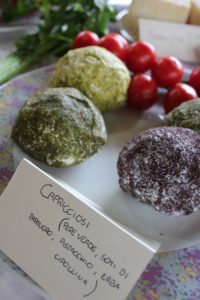Who doesn’t love Italian cheese?
Italians and Sicilians in particular do cheese so well, that’s why I love to incorporate Italian Cheese as part of my Italy food tours!
“Age is something that doesn’t matter unless you are cheese”.
On my recent tour of Eastern Sicily, I with the assistance of our wonderful chef Massimo, showcased a great selection of local Sicilian cheeses. We enjoyed these with a selection of Sicilian wines. The thrill for me was seeing everyone’s expression when we arrived and were confronted with a table full of cheese. We were like mice in a cheese shop! I have listed the Italian cheeses we enjoyed and a little bit of information on each so if you come across them in your travels, you will know what you are eating. Buon appetito!
Italian Cheese piece by piece
 Pecorino
Pecorino
The name “Pecorino” from the Latin “pecus” meaning sheep. Back to the sheep’s milk it is definitely one of the oldest cheeses dating back to Sumerian Mesopotamia where a pastor randomly invented the technique of production. The taste is crisp and grainy with a very spicy flavour . Pecorino is a term used to define one of the older styles of cheeses made from unpasteurized sheep’s milk. It is a protected origin, DOP, made everywhere in Sicily but using different styles of cheese making. In the area of Mt Etna, they make the cheese in a flatter style of wheel with raw sheep milk and leaving it to mature for about 2 years, becoming firm and granular with age. Farmers love to have their sheep grazing on the wild mountain herbs as they impart a particular kind of flavour.
Pecorino is one of most widely used, sharper cheeses used in Sicily and has aromas of fresh, floral and spicy or fruity and spicy, especially if mature. It usually will have a strong smell of sheep’s milk and hay and because of the hard texture and sharp & salty flavour. Commonly, Pecorino is flavoured with black pepper, chili or basil although some more unique flavourings include, pistachio, saffron, capers and orange. Pecorino is an excellent cheese grated over pasta dishes, salads and mixing with other cheeses to create a sharp flavour in gratin dishes and stuffings.
Piacentinu Ennese
Piacentinu Ennese is a very important cheese from the year of around 1090. This is also a sheep’s milk cheese, exclusively produced in the Enna Province in Sicily. Legend says that King Roger was looking for ingredients to cure depression for his wife. Some local cheese makers said that saffron was good for depression and made this cheese for the queen. Its name takes origins from the dialect word “piacenti” that means” cheese that is liked.” This is a full fat, raw or heat treated sheep’s milk cheese usually aged for 60 days.
Piacentinu Ennese has a beautiful mild flavour with amazing flavours, its bright yellow distinctive colouring uses both the raw milk of red-faced ewes and local picked saffron. The saffron gives the cheese a rich, golden colour with aromatic flavours, slightly sweet and a compact paste that is lightly holed. The saffron has to be picked at a certain time when the flower is not complete. The farmers wake before sun rise to pick between two to three thousand saffron flowers!
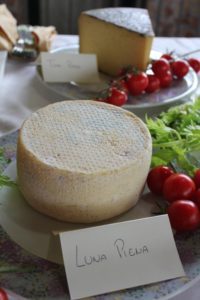 Luna Piena
Luna Piena
Luna Piena – this cheese is so local that it was really difficult finding information on it. It is covered in a light mould with a soft mild flavour made in the area of Ragusa in the mountains about 900mt above sea level on the Eastern Coast of Sicily.
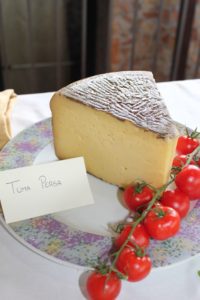 Tuma Persa
Tuma Persa
Tuma Persa is a very old style of Italian Cheese with its recipe having been almost lost for 100 years until it was rediscovered again by cheese maker Salvatore Passalaqua. He found the old artisanal recipe in a house just outside of Palermo. Now Salvatore is the sole producer of Tuma Persa or “Lost Cheese,” producing it in Castranova di Sicilia near Palermo in Sicily. Tuma Persa is extremely flavourful, but not salty. Made from raw cow’s milk, it has an earthy taste with a sharp finish. The rind is coated with crushed peppercorn, which further adds to its complex flavor. Tuma Persa is best enjoyed by itself or with Sicilian Caponnata. And it’s wonderful paired with indigenous Sicilian wines such as Nero d’Avola, Syrah, Malvasia from Lipari and Passito from Pantelleria.
Ragusano Dop tipical sicilian
Ragusano is a stringy‐textured cheese, produced with raw whole cow’s milk, coming from cows that forage in the aromatic pastures of the Iblei Mountains that lie between Siracusa and Ragusa. The Ragusano Dop is one of the oldest cheeses produced in Sicily. They are evidence of the presence of Ragusano DOP in Sicily history starting as early as 1500, The cheese is still homemade by little family dairies included in the farm where the cows are reared and its production is limited to seasons when the Ibleo pastures are very lush. This is protected by DOP made in one region with one type of cow and can only be made in this area.
The flavour of Ragusano Dop is aromatic, slightly spicy with a very pleasant taste. It tends to be aromatic and sweet when the cheese is young and becomes more and more pungent by the extension of the period of maturation. The production of Ragusano DOP follows an ancient tradition. The milk of one or more milking’s is left to clot, promoting the development of the natural microflora. The curd is then reduced into small pieces using the “iaruozzu”, a wooden pole that ends with a disk. The Ragusa-caciocavallo cheese ferments for 24 hours before the cheese is placed in hot water then stretched, calling it -pasta filata. It is then matured for 1 ½ years hung in two balls over what can be described like a saddle.
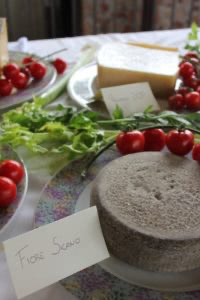 Fiore Sicano
Fiore Sicano
Fiore Sicano is a flat round Italian Cheese with a greyish native mould produced between the regions of Palermo and Agrigento in the Sicani mountains. The birth of the Fiore Sicano cheese is accompanied by a very unique legend. It is a wonderful story of a cheese maker who failed to work the milk properly. Starting with something like a “tuma” fresh stretched cheese, he formed it into a round. Not wanting to throw it away he left it to mature, the story says, near fruits. The cheese maker noticed that the cheese was producing a mould. Thinking that the Tuma had gone bad he decided to throw it away. At this point he noticed the white soft cheese that came out of the centre. The natural moulds that characterize the native flower Sicano give the cheese a slightly acidic taste. Although, the delicate aroma of cream and milk gives it a sweet after taste which softens the initial acidity.
Fiore Sicano is still produced according to ancient tradition, with typical wooden tools. Cow’s milk from two milkings is left to coagulate for about an hour in a wood casks called “chiscuni.” The curd is broken twice: the first using a light technique, the second with force, until the granules are reduced to the size of a grain of rice. Then the curd is separated from the whey and is collected in forms. After twenty-four hours, the cheese is immersed in brine. Seasoning is added at the last stage of the production process and can last for sixty days or twenty months. This cheese like many of the others matches extremely well to the wines of the Sicilian land, and wines such as Grecanico and Nerello Mascalese.
“Formaggio Ubriaco” (drunk cheese) di nero d’Avola
This is a sharp cow milk cheese aged for 6 months on its own. Then aged for an extra 5 months in wine barrels with the Sicilian Nero d’Avola a deeply coloured, full-bodied, distinctly tannic wine. Nero d’Avola essentially is an indigenous grape variety to the region of Sicily, where it has been cultivated for centuries. The name is thought to be a contraction of two words (“Calea” and “Aulisi”). In the Sicilian dialect, it means “grape from Avola” (Avola being the name of a Sicilian town). This is also a stretch curd cheese sometimes also aged with the other Sicilian grape, Zibbibo . The creamy richness of the cheese marries well with the distinct flavour and aroma of the wine. This varies according to the preferences of the cheese maker. This cheese is enjoyed when served with potatoes, partnered with polenta and or mushrooms.
These goats cheeses are from the Province of Agrigento and are made from a specific breed of goat with the milk being similar to that of human milk – good for people who diabetic, or with an allergy to cows milk and also very good for children.
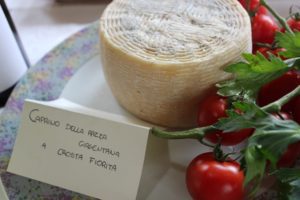 Caprino Della Razza Girentana a crosta Fiorita
Caprino Della Razza Girentana a crosta Fiorita
The origins of this cheese dates back to the eleventh century BC. This Sicilian goat cheese is unique in their kind, produced between the Nebrodi and the Madonie regions in Sicily. The milk is obtained from goats and Maltese Girgentana that feed exclusively on wild herbs and plants, which are present in inaccessible areas and thus difficult to reach. This diet gives the cheese its unique taste. The fatty acids and aging of the cheese give the cheese its characteristic odour and sharp flavour , sour initially and later herbaceous pleasing to the palate.
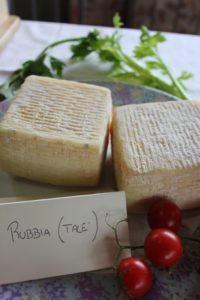 Rubbia
Rubbia
These are a softer, velvety and creamier style of Italian Cheese with an edible rind. White and clean in flavour with a delicious simple style. This is an elegant version of the traditional soft cheese from the valleys of Brescia. Made from cow’s milk and aged for about 30 days, it has the typical shape almost like a taleggio and with the ripening tends to completely “cremificare”.
Calricciosi
Calricciosi are soft balls of goats cheese coated in a variety of either spices, herbs or seeds. A delicate flavour with those gorgeous hues of a fresh goats chevre here in the images are three different types of coatings. Peppe verde – rolled in green peppercorn; Semi di Papavero – rolled in poppy seed and Pistachio e erba cipollina – rolled with green chives and pistachio.
Infogliato Ficu
Infogliato Ficu is a delicious soft goats cheese. It is infused with the flavour of fig as it is wrapped and left in fresh fig leaves.
Experience the very best Italian cheese with Dominque Rizzo
Let me take you on a culinary adventure to “God’s Kitchen” the amazing Puglia and Sicily! If you would like more information contact me.

